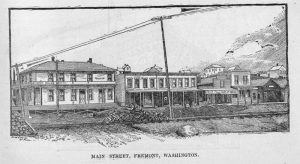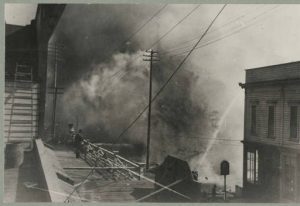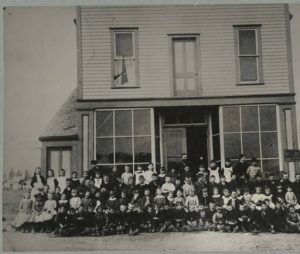by Kirby Lindsay Laney, posted 23 July 2014

At the end of the 1800s, Fremont really started to coalesce and grow as a community. The town became a township. Buildings, transportation and industry started here, and converted the heavily wooded outpost into a thriving suburb of Seattle.
Fremont grew a lot at this time, particularly in 1889, the same year as The Great Seattle Fire. The wild growth of Fremont, and the devastation of Downtown Seattle, might appear – at this distance – as related. Yet, a December 1889 publication, made available digitally through the Seattle Public Library Neighborhood History Project, gives an account of these events as unrelated. The Christmas supplement to ‘Washington Magazine,’ called ‘Seattle Since The Fire’, actually gives a shockingly rosy, immediate account of both Fremont and Seattle.

Starting On June 6th, 1889
The Great Seattle Fire took place on June 6th, 1889. It started when a heating pot of glue caught fire, at approximately 2:30p. Accounts vary, but by June 7th, from 64 – 120 acres of the prosperous and bustling city lay in utter ruin.
Rudyard Kipling happened to be touring the Puget Sound at this time. He arrived in Seattle by a steamer ship and described the devastation he witnessed as, “a horrible black smudge, as though a Hand had come down and rubbed the place smooth. I know now what being wiped out means.” (From a HistoryLink essay by Greg Lange.)
The fire destroyed homes and businesses, and all the infrastructure including a series of wooden water pipes, wharves and roadways. “In fact, every vestige of what had been that morning a bustling hive of life and industry, was utterly wiped out as if it had never existed. Never was there a cleaner sweep,” was the description in “Seattle Since…”

Every mill and factory was destroyed – an estimated 125 businesses – which included boiler works, broom factories, creosoting works, bridge builders, carriage factories, foundries, ship yards, soap works, tanneries, sheet iron works, and mattress factories. Washington Magazine also states, “it was calculated at the time that over 800 business and professional firms were burned out.”
For a conflagration that consumed so much so quickly, the loss of life was surprisingly low. One report, on Wikipedia, states a young boy, named James Goin, perished in the Great Fire. One horse did die, and thousands of rats.
Perhaps more surprising, given the way the fire laid waste to the city, is the way the extensive damage may have contributed to its ultimate prosperity. As Lange wrote for HistoryLink, “this fire…ironically transformed Seattle from a town to a city.”
In 1885, the territorial census of Seattle’s population counted 9,687 people. The general population estimate after the fire is 30,000, and a Seattle.gov Municipal Archives article states that in the year following the fire the population increased by 33%. By the publication of the Washington Magazine Christmas Supplement, the authors reported, “there have been 261 new firms established in Seattle since June.”

As written in ‘Seattle Since…,” in December 1889, “Hardly had the flames died out when anxiety and dread gave place to cheerfulness, confidence and a determination to face and overcome the difficulties of the occasion. Then the sterling qualities of the men of Seattle shone forth in their hour of their trouble. It was neighbor helping neighbor, offering the hand of assistance to friend and foe alike.”
‘The Town Of Fremont’
‘Seattle Since…’ also gave information on three of Seattle’s “suburbs,” and the remarkable growth being seen there. The three small towns highlighted are Queen Anne, West Seattle and Fremont.
About “the town of Fremont,” Washington Magazine reports, “It contains at the present time over 2000 inhabitants, but a little over a year ago it was nothing but forest.”
In the year before the Great Fire, M. Edward Blewett, of Fremont, Nebraska, had secured a large tract of land, got it platted and then cleared. He encouraged development of the area through the expediency of land donations to those who would put it to work – for machine shops, tanneries, furniture factories, foundries, brick yards, and a broom factory.

That same year, 1888, Fremont’s first mill – Bryant Mill – opened. Plenty of wood, from the hills rising up from Lake Union, gave the mill plenty of work before The Great Fire. However, in the summer of 1889, Bryant Mill would find its customer base greatly expanded, and the availability of skilled workers increased.
Right Place, Right Town
E.C. Kilbourne, a dentist who invested his earnings in real estate, like Blewett, also had amazing timing. Kilbourne purchased 40 acres on the north shore of Lake Union where he, according to a biography by Louis Fiset for HistoryLink, envisioned absorbing the overflow of Seattle’s expanding population. In 1888, Kilbourne formed a partnership with L.H. Griffith to promote the 240-acres of the Denny & Hoyt tract – most today’s central Fremont district. In late 1889, Kilbourne would also receive Seattle’s franchise to restore electric power to the city.
In early 1889, Guy Phinney purchased 200 acres north of Fremont. In four days starting on May 17, 1889, with Daniel Jones and Benjamin F. Day, Phinney started the Woodland Park Electric Railway, had 175 housing lots platted, which he called the Woodland Park Addition, and established his personal estate on the top of what is now Phinney Ridge.
The electric railway (a street car) wouldn’t begin running until 1890, but then it would bring people, from Seattle, where the population continued to expand, through Fremont to Phinney’s estate. ‘Woodland Park’ had an English park, bandstand, ballpark, and a menagerie of animals. Visitors could enjoy an afternoon’s leisure in the Park, and see the new homes being built, and sold.

Nothing Into Something
The Great Fire devastated the people of Seattle but ‘Seattle Since The Fire’, written in 1889, captures the wonder and admiration of the region for a city – and surrounding towns – where people pulled together and turned nothing into something. This Christmas Supplement to Washington Magazine includes Fremont in that amazing legacy.
As to we, the beneficiaries of that remarkable transformation, it is worth going back to read what those writers thought of their world, now long gone. Visit the Seattle Public Library Neighborhood History Project website for more photos, articles and ephemera of our past.
Related Articles
- SPL History Share: Fremont Founders – Stone, Kilbourne & Phinney
- by Kirby Lindsay, April 21, 2013
- The Street You Live On: An Abridged History Of Fremont Street Names
- by Kirby Lindsay, May 26, 2013
- Seattle Public Shares Fremont History
- by Kirby Lindsay, April 1, 2013
©2021 Kirby Laney. This column is protected by intellectual property laws, including U.S. copyright laws. Reproduction, adaptation or distribution without permission is prohibited.

